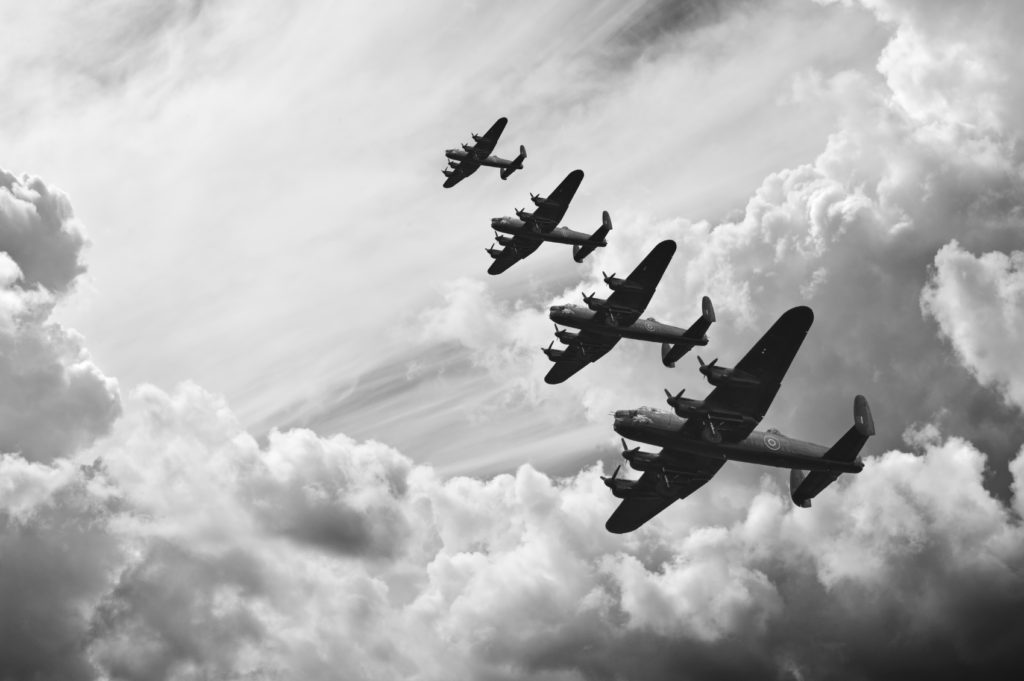Table of Contents
The War in Europe
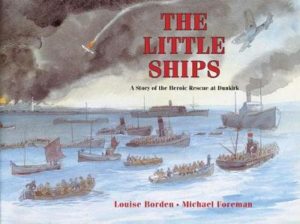 |
Louise Borden’s The Little Ships (Margaret K. McElderry, 2003) is the picture-book story of the evacuation of the trapped British army from Dunkirk in 1940, in large part by fleets of volunteers in fishing boats – the “little ships.” The story is narrated by a young girl who accompanies her father across the English Channel. For ages 7-11. |
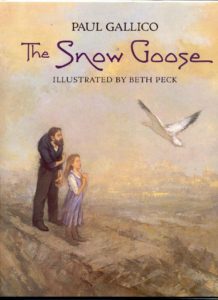 |
Paul Gallico’s novella The Snow Goose (Alfred A. Knopf, 1941) is the story of the solitary hunchback Philip Rhayader, who lives in an abandoned lighthouse on the English seacoast, and a young girl, Fritha, with whom he forms a bond when together they save the life of a wounded snow goose. The bird returns to the lighthouse year after year – finally visiting Fritha one last time after Rhayader and his boat are lost evacuating soldiers from Dunkirk. A beautiful book and an enduring classic for ages 13 and up.
|
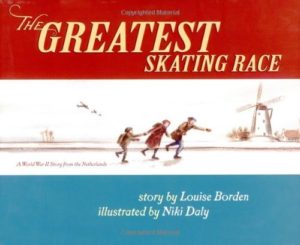 |
In Louise Borden’s The Greatest Skating Race (Margaret K. McElderry, 2004), it’s 1941, and in the Netherlands young Piet has been given the task of skating two neighbor children to safety, across the frozen canals and into Belgium. The trick: to look like three kids out to play. For ages 7-10. |
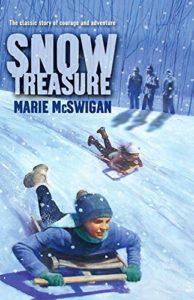 |
Marie McSwigan’s Snow Treasure (Puffin, 2006) is the exciting story of young Peter Lindstrom and friends who, in Nazi-occupied Norway, managed to smuggle nine million dollars’-worth of gold out of the country to safety by hiding it on their sleds. For ages 7-11.
|
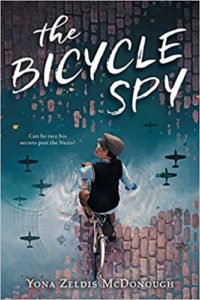 |
In Yona Zeldis McDonough’s The Bicycle Spy (Scholastic, 2020), set in France, young Marcel dreams of someday competing in the Tour de France – though his bicycle skills come into play in World War II as he smuggles secret messages along with bread from his parents’ bakery. For ages 8-12.
|
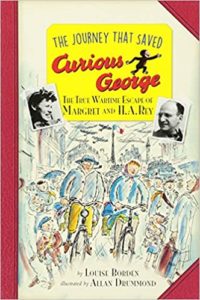 |
Illustrated with photos and cartoon drawings, Louise W. Borden’s The Journey That Saved Curious George (Houghton Mifflin Harcourt, 2010) is the story of how Hans and Margret Rey fled Paris on bicycles as the German army moved in, carrying their children’s manuscripts with them. Written in the form of a travel journal. For ages 8-12.
|
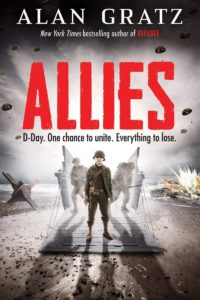 |
Alan Gratz’s Allies (Scholastic, 2019) is a gripping story of D-Day, told from the points of view of a soldier on a transport heading for the Normandy beaches, a paratrooper, a medic, and a girl who works as a spy behind enemy lines in France. For ages 9-12.
|
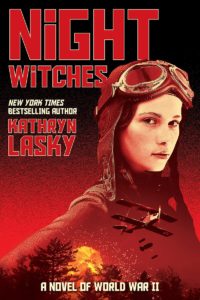 |
Kathryn Lasky’s Night Witches (Scholastic, 2017), through the eyes of 16-year-old Valya, is a fictionalized story of the brigade of daredevil Russian female pilots who – flying at night – stalked the German invaders. For ages 9-12.
|
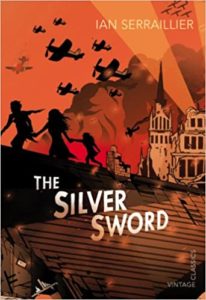 |
In Ian Seraillier’s now-classic The Silver Sword (Vintage, 2012), Joseph Balicki – a schoolteacher in Nazi-occupied Warsaw – and his wife have been sent to Nazi prison camps. Their three children, Ruth, Edek, and Bronia, left on their own, must survive in war-torn Poland and struggle to find their parents. A Scholastic version has been published with the title Escape from Warsaw. For ages 9-12. |
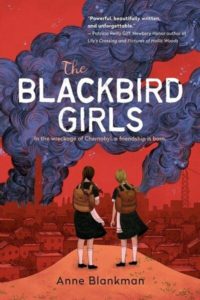 |
In Anne Blankman’s Blackbird Girls (Viking, 2020), set in Ukraine and Russia, the story alternates between that of Valentina Kaplan and Oksana Savchenko in the aftermath of Chernobyl and that of Valentina’s grandmother, Rifka, trying to survive in Ukraine during World War II. For ages 9-12.
|
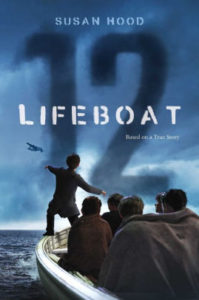 |
Susan Hood’s gripping Lifeboat 12 (Simon & Schuster, 2019) is the story of 13-year-old Ken and the other survivors in his lifeboat after the City of Benares, the ship carrying evacuated children from England to Canada, is torpedoed. An edge-of-the-seat read for ages 9-13. Also see Deborah Heiligman’s Torpedoed: The True Story of the World War II Sinking of “The Children’s Ship” (Henry Holt, 2019). |
 |
In Marsha Forchuk Skrypuch’s Making Bombs for Hitler (Scholastic, 2019), Lida’s Ukrainian family has been torn apart by the Nazis, and Lida and other Ukrainian children have been sent to a work camp. When they’re assigned to make bombs for the German army, Lida and her friends turn to sabotage. For ages 10-14. |
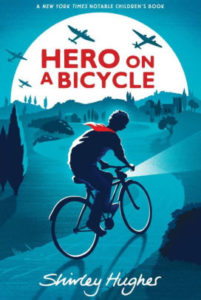 |
In Shirley Hughes’s Hero on a Bicycle (Candlewick, 2017), set in 1944 in Nazi-occupied Italy, 13-year-old Paolo and his older sister Constanza – armed only with a bicycle – find ways to aid the Italian resistance, and to deceive the Gestapo, while hiding Allied escaped prisoners of war. An exciting read for ages 10-14. |
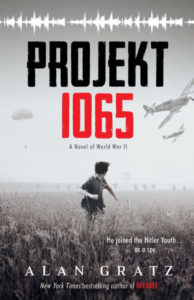 |
In Alan Gratz’s Projekt 1065 (Scholastic, 2016), young Michael O’Shaughnessy and his parents live in Nazi Germany, where Michael is an upstanding member of Hitler Youth. In reality, however, all are spies for the Allies. A thriller for ages 12 and up.
|
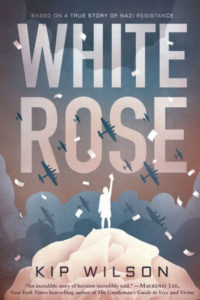 |
Kip Wilson’s White Rose (Versify, 2019), a novel in verse, is the story of German student Sophie Scholl, whose organization – called the White Rose – distributed pamphlets opposing the Nazi regime and calling German citizens to action. Sophie and her brother were arrested for treason and executed. A story of incredible courage for ages 12 and up.
|
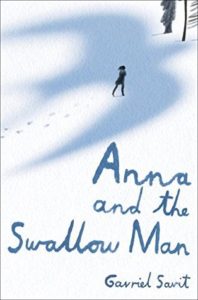 |
In Gavriel Savit’s Anna and the Swallow Man (Ember, 2017), set in Poland during the Second World War, seven-year-old Anna’s father has been taken to a concentration camp, leaving Anna alone. Anna then meets up with the mysterious Swallow Man – who speaks many languages, including Bird – and the two spend the years of the war hiding in the Polish forests, close to the Eastern Front. A powerful and poignant story for ages 12 and up.
|
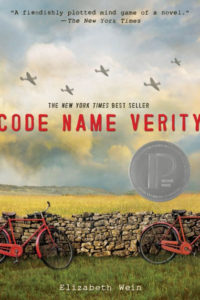 |
In Elizabeth Wein’s gripping Code Name Verity (Little, Brown, 2013), Julie – a British spy with the code name Verity – is captured by the Gestapo behind enemy lines and does her best both to save herself and to protect the pilot who brought her there. For ages 13 and up. Also by Wein, see Rose Under Fire (Little, Brown, 2014), in which Rose, flying an Allied fighter plane, is captured by the Nazis and sent to the Ravensbruck concentration camp.
|
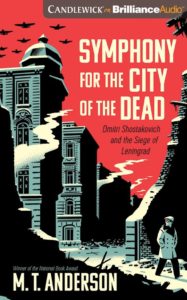 |
In M.T. Anderson’s award-winning Symphony for the City of the Dead (Candlewick, 2017), it’s 1941, the German army has surrounded Leningrad, and the city is under siege – and composer Dmitri Shostakovich is writing a symphony to commemorate, encourage, and rally his fellow citizens. Illustrated with period photos. For ages 13 and up. |
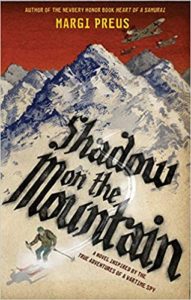 |
Marji Preus’s Shadow on the Mountain (Harry N. Abrams, 2014) is the story of 14-year-old Espen, who joins the Norwegian resistance movement after the Nazis occupy his country. He begins by delivering illegal newspapers and later graduates to full-fledged spy, dodging the Gestapo, until he’s eventually forced to flee on skis across the border to Sweden. Based on real-life events. For ages 13 and up.
|
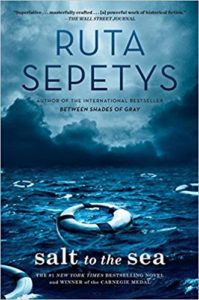 |
Ruta Sepetys’s Salt to the Sea (Penguin, 2017) is the intertwined story of four young refugees, trapped between the Germans and the advancing Russian army, and all hoping to escape on the ship Wilhelm Gustloff, which was sunk by a Soviet submarine in January 1945. Of the 10,500 people on board, at least 9000 drowned. A tragic and wonderful book that still shows the value of hope and human connection. For ages 13 and up. |
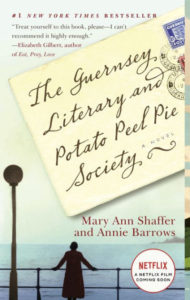 |
By Mary Ann Shaffer and Annie Barrows, The Guernsey Literary and Potato Peel Pie Society (Dial, 2009) is an epistolary novel set just after World War II, in which London journalist Juliet begins a correspondence with the inhabitants of the island of Guernsey, all members of the Guernsey Literary and Potato Peel Pie Society. Eventually she travels to the island, meets a wide range of captivating characters, and listens to their stories about the German invasion and five-year occupation of Guernsey. Humor, sadness, gentle romance, and moments of horror – and a wonderful read for booklovers. For teens and adults. |
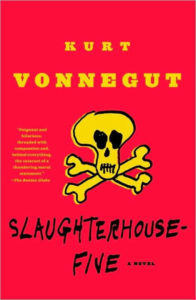 |
Kurt Vonnegut’s now-classic Slaughterhouse-Five (Dial, 1999) centers around the firebombing of Dresden, which main character Billy Pilgrim experiences as a German prisoner of war. Billy, kidnapped by Tralfamadorians and held prisoner in an alien zoo, becomes unstuck in time. (Yes, really.) It’s a fascinating book and a must-read for teens and adults. |
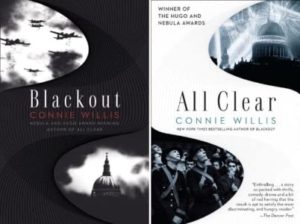 |
Connie Willis’s Blackout (Spectra, 2010) begins in the Oxford of 2060, when historians routinely time-travel into the past. Michael Davies is planning to head for Pearl Harbor; Merope Ward – who really wants to go to VE-Day – is in 1940 dealing with obstreperous evacuees; and Polly Churchill is preparing to go to the Blitz. Then sometime goes wrong – and the three are stranded in time for the duration of the war. Also see the sequel All Clear, which won the Nebula Award. Science fiction, with a lot of memorable and well-researched World War II history. For teens and adults.
|
